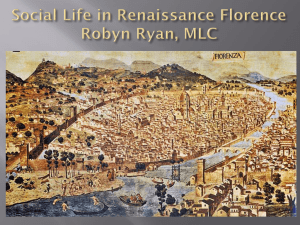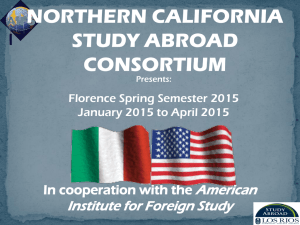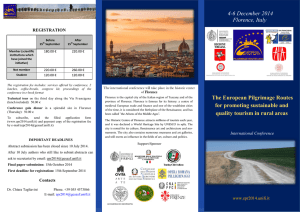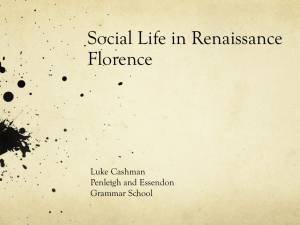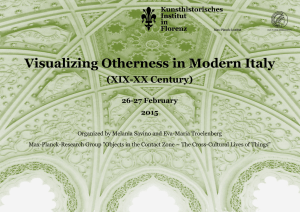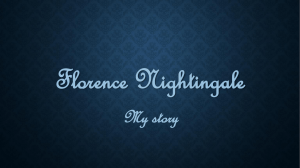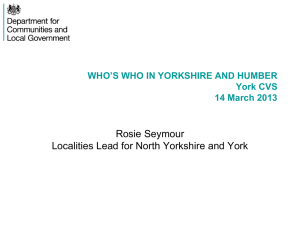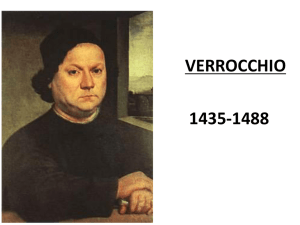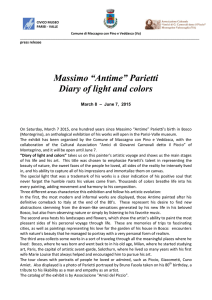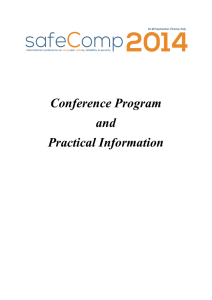Unit 4: Area of Study 1 Social Life in Renaissance Florence
advertisement
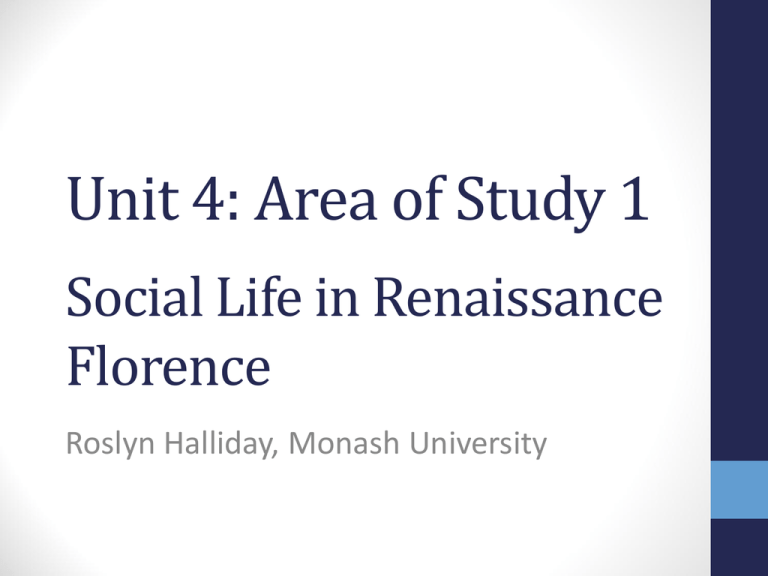
Unit 4: Area of Study 1 Social Life in Renaissance Florence Roslyn Halliday, Monash University Florentines lived in close proximity which affected their social relationships. Gene Brucker, Renaissance Florence, p.23 The plan for the session…. 1. Key knowledge 2. More detail on some key knowledge points 3. How to approach the essay Study Design - Preamble • Italian city-states such as Florence and Venice possessed distinct social structures shaped by their economic and political bases. These social hierarchies were reflected in many aspects of everyday life such as dress, housing, food, entertainment and the social map of the city based on neighbourhoods. There is historical debate over just how important neighbourhoods, gonfalone in Florence and sestieri in Venice, were to political, economic, social and religious aspects of life at this time. • While it is agreed that a range of social relationships were crucial to a Florentine or Venetian citizen’s existence, historians have variously described them as competitive, pragmatic or co-operative typified by economic and political networks, but rarely as personal ties like love or friendship. The functional view has been shaped by evidence of conventions such as the strategic location of families within neighbourhoods, marriage contracts and dowries, and the institutionalisation of charity. • Within each city, many people, such as the urban poor, foreigners and ‘deviants’, fell outside the networks created by the dominant elite. Historians have suggested that various means, such as legislation (e.g. controlling foreigners, prostitutes and homosexuality), institutionalised charity and festivals were used to incorporate these groups into, or exclude them from, city life in the interests of civic harmony. • Students will investigate the nature and role of social conventions and relationships based on location, wealth, gender, class, or inclusion within or exclusion from the cities mores. Key knowledge This knowledge includes: 1. The social structure of Florence during the Renaissance; 2. The social map of Florence and how it reflected social identity, wealth, gender and class relationships; 3. The importance of aspects of social life such as family, marriage, dowries, charity, social legislation and festivals to the life of the city. 1. Social Structure • Relates to one’s position within Florentine society in terms of status, honour, wealth, political involvement • Social hierarchies shaped by economic and political bases 2. Social Map • Based on neighbourhoods (gonfaloni) • The gonfalone and the relationships within it (inlcuding those of parenti, amici, vicini, parishes) • The nature of these relationships: whether they were cooperative or competitive; whether they were characterised by love and friendship as we understand it • How important the gonfalone was to political, economic, social and religious aspects of life at this time • More specifically: social identity, wealth, gender, class relationships 3. Aspects of social life • People who fell outside the networks created by the dominant elite • Eg. urban poor, foreigners, ‘deviants’ • How these people were incorporated into, or excluded from, city life in the interests of civic harmony • Eg. through festivals, legislation, institutionalised charity The nature of social relationships • Weissman: “The essential feature of the Florentine social bond was its agonistic character” • ‘dense, multitextured social network’ • “The more extended one’s network, the greater were one’s chances of worldly success” • Alberti: ‘One has to be far seeing…in the face of frauds, traps and betrayals’ The dowry • Sometimes a larger dowry would be offered in order to marry “up” • Sometimes a large dowry was to compensate for something else (apart from low social status). Alessandra Strozzi: “Things do not go so high unless there is a defect.” • Poor girls who did not have a dowry usually went to a convent. Sometimes they were donated a dowry eg. by a confraternity • The Dowry Fund – est. 1425 by the Signoria. Fathers deposited money in the monte for each daughter (ie. with the govt) 100 florins deposited for 7.5 yrs = 250 florins 100 florins deposited for 15 years = 500 florins (Kirshner and Molho,’ The Dowry Fund and the Marriage Market in Early Quattrocento Florence’ in The Journal of Modern History, Vol 50 (3), Sept 1978, pp.403-438) By way of comparison, Alessandra Strozzi’s dowry was 1600 florins, although this was regarded as extraordinarily high. (Anne Crabb) Beyond parenti, amici, vicini…. How else did Florentines forge social networks? 1. Marriage •Girls were usually married at the age of 16 to men who were around 30 years of age or more (Tomas) •Linking families, creating allies for social, economic, political benefit •Marriage was ‘the cement that bound together this elite’. (Brucker) •Alessandra Strozzi letters. 2. Parishes •Rich and poor came together in local parish church •“A large part of Florence’s collective identity was created and transformed in public ritual . . . there was little distinction between Drago’s parish life and that of its community, and parish was most assuredly a community – as much as an ecclesiastical - affair.” (Eckstein p. xxiii) Beyond parenti, amici, vicini 3. Confraternaties •Voluntary associations – worship, charitable acts and sometimes other rituals •Usually membership came from all over the city – allowed for interaction between different parishes, gonfalone and quarters •Alsointeraction between different social classes •Means of securing networks of friends/patrons outside of neighbourhood Charity was an important part of confraternaties •eg. Company of San Frediano called Brucciata - located in poor area in south of the Arno (gonfalone of Drago Verde). Distributed bread to poor, buried the dead, provided dowries to poor girls. Lorenzo de’ Medici joined 6 confraternaties •Helped extend his networks •Also helped keep his finger on the political pulse of potentially disruptive groups (Nicholas Terpstra) Beyond parenti, amici, vicini 4. Patron – client relationships •Critical to one’s network of social relationship •Example of Cederini The story of Cederini F.W. Kent, Bartolommeo Cederini and His Friends: letters to an obscure Florentine, 1990 •Cederini (1416-1482) did not come from old extensive family like Rucellai or Sassetti. He was without family of significance. •His career and connections may be explained by the “horizontal and vertical ties of clientage” that existed in quattrocento Florence. (ie. patronage) •Importance of “friends of friends” (p.10) •His network didn’t centre around the gonfalone. He had a weak position in the neighbourhood so he sought connections outside of it. •Difference between rich and poor •“…personal contacts and inside knowledge about personalities and their connections were essential for advancement, if not survival.” (p.38) •“Friendship in this complex sense would have constituted the most significant social bond to Florentines such as Cederini…” (p.47) Cederini • “Neighbourhood, kinship and friendship: these were for the ‘honourable’ classes the ingredients of social life in Renaissance Florence. Like a good cook, the city’s historian can and should vary the amount of each ingredient – more friendship and less patri-lineal kinship for Cederini, a more balanced mixture for Giovanni Rucellai and the Medici, and so on – but cannot make do without them.” (Kent, p.47) Inclusion and Exclusion • Who was INCLUDED and EXCLUDED from society? • How? • In the interests of civic harmony Exclusion: • Women, Jews, homosexuals, prositutes • Largely through legislation Inclusion: • Festivals • Institutionalised charity Inclusion and Exclusion - homosexuals Inclusion and Exclusion - prostitutes Gene Brucker, The Society of Renaissance Florence: a documentary study, New York, Harper & Row, 1971 Inclusion and Exclusion - Jews Gene Brucker, The Society of Renaissance Florence: a documentary study, New York, Harper & Row, 1971 Essay writing 1) It sounds obvious, but ANSWER THE QUESTION! 2) Construct an ARGUMENT (don’t just write everything you know) 3) Support your argument with EVIDENCE – primary and secondary sources. • • • • Quotes (from primary and secondary) Paraphrasing (from primary and secondary) Examples Employ the ‘SO WHAT?’ principle. After every quote or example say why you have put it there; what does it tell us? Some examples… 2005 Exam Question In his Ricordi the Florentine merchant Giovanni Morelli advised his sons: ‘to become familiar with the men of substance in your neighbourhood…’ Discuss how the social map of Florence reflected social identity. How to approach the essay 1) Turn statements into questions to be answered: In what ways did the social map reflect social identity? 2) Highlight key words – SOCIAL MAP and SOCIAL IDENTITY. Also in the quote - NEIGHBOURHOOD 3) Define key terms (so you know what you’re talking about!) - Social map: to do with gonfalone; networks of relationships including parenti, amici, vicini; also confraternities, parishes - Social identity: one’s position within Florentine society in terms of status, honour, wealth, political involvement Approaching the essay cont’d So another way of asking the same thing would be: How did the gonfalone/neighbourhood & the relationships in it reflect one’s position/involvement in society? 4. Brainstorm ideas •The gonfalone both reflected and affected social identity •Tax and political eligibility were decided at the level of gonfalone •Gonfalone was central to the formation of social identity through relationships of parenti, amici, vicini as well as parish •Relationships beyond the gonfalone were also important to shaping social identity eg. confraternity and patronage 5. Do an essay PLAN INTRODUCTION The gonfalone both reflected and shaped one’s social identity in Renaissance Florence. The gonfalone was central to the formation of ones’s social identity as it was at this local level that political eligibility and taxation was decided. It provided the Florentine with a strong sense of tradition and honour and is described by FW Kent as being a ‘sacred space’ to families. The relationships formed within the gonfalone, including those of parenti, vicini and amici, were central to the formation and development of one’s social identity; however, social bonds formed beyond the gonfalone, including those developed through confraternaties and patronage, were also important to achieving social, political and economic success. Para 1 TOPIC SENTENCE: The gonfalone provided patrician families’ with a strong sense of lineage and family honour which was integral to maintaining or augmenting one’s social standing. EVIDENCE •In 1427 nearly all of the 23 houses of the Rucellai family lived on the same street and this continued for at least the next century (FW Kent) Geographic ties were crucial to their sense of identity. •Lineage was physically reflected in the large palaces they built on ancestral land (built to reflect their wealth and to bring honour to the family name). Para 2 TOPIC SENTENCE: The gonfalone was important to a family’s political success as it was at this level that political eligibility was decided. EXPLANATION: Family solidarity within the gonfalone was particularly important for those of the political class, as the consolidation of family member sin the same district strengthened their political might. Holding political office was the key to social standing (Kent and Kent) EVIDENCE: •Kent and Kent – ‘it was in the gonfalone that citizens set their feet on the bottom rung of the ladder in the long climb into the ruling group and up through it to the very top of the social pyramid.” •Eckstein notes that ‘citizens habitually sought to guarantee political and economic success for themselves and their families by transforming neighbours into relatives.” •Morelli advised his sons ‘to look first within your own gonfalone and if you can make a marriage there you should be readier to do so than elsewhere’. Para 3 TOPIC SENTENCE: The relationships forged within the gonfalone could directly affect one’s economic success through the levying of taxes. EXPLANATION: Under the estimo system of taxation which survived until 1458 (replaced by the Catastoin 1427-34 and after 1458), the gonfalone held the responsibility of determining the amount of tax to be paid by its residents. Taxation could be used by powerful men to either promote or destroy families. EVIDENCE •Francesco Datini wrote a chapter in his diary called, ‘How we left the Borgo [Santa Croce] because of the great taxes we received from our neighbours’. •Morelli advised his sons, ‘don’t advertise that you are rich. Instead, do the contrary…’, so to avoid a heavy tax assessment. Para 4 TOPIC SENTENCE: It was important that relationships outside of the gonfalone were cultivated for political and economic success within the city, for example through confraternities and patronage. EVIDENCE: •Weissman: ‘The more extended one’s network, the greater were one’s chances at worldly success” •FW Kent’s study of Cederini – he had a weak position within his gonfalone, so he sought connections outside of it, particularly through ties of patronage. Conclusion The gonfalone was integral to one’s political, economic and social success within Florentine society. •Re-state main points (look at your topic sentences) •Could suggest relationships within the gonfalone may have been more important to those from patrician families (FW Kent) Other essay questions and examiners’ reports 2009 Examination In what ways were the Florentines who were not part of the dominant elite included in the social life of the city? In your response you must draw on a range of evidence and relevant historians’ views. Examiners’ report • Need to go beyond a general description of Florentine social life • Identify the institutions, events and locations where rich and poor, males and females interacted. • Many students simply recited the parenti, amici and vicini and added that it was important for all to have friends and marry well. This very general approach was not an appropriate response to this question. • Florentines prayed together and so the Parish would have been a useful area to examine. The Confraternities were engaged in charitable work and their support of the poor was evidence of the relationship between the elite and the rest of the population. Festivals were occasions where many of the different groups in the city came together. Although many students touched on festivals, they often did not give examples or did not go on to discuss the social interaction the festival provided for. Some excellent answers considered the arrangements that were made for poor women through the Dowry Fund and others discussed the regulation of the lives of prostitutes and homosexuals. There was some good writing that made use of the government control of the granary and the distribution of grain that occurred in times of famine with the resultant social interaction. Examiners’ report Following is the beginning of an excellent response to this question. Although the dominant elite profited the most from Florentine social life, those from a lesser social standing and background were still included in this life. Brucker says that each gonfalone was a ‘melange of palace and cottage’ emphasizing the social and economic heterogeneity of each neighbourhood and thus apotheosizing this concept of all classes taking part in social life. One of a limited social status could ‘gain access to the networks of others’, (Weissman) through the friendship of the elite. One could take part in the festivals of the city, which joined rich and poor alike. Charity was another means of ensuring that all Florentines could contribute to the city’s social life. Despite this, there were deviant groups such as the Jews and prostitutes, who although discriminated against were still accepted in society. Another one to try 2008 Examination To what extent can neighbourhoods (gonfaloni) in Renaissance Florence be described as competitive and/or cooperative in relation to social life? Examiners’ report This question provided students with the opportunity to discuss the cooperative aspects of Florentine neighbourhoods and the advantages the individual could derive from the neighbourhood. Points could have been made about the heterogeneous quality of the neighbourhood and the cooperation that institutions like the parish and the confraternity could bring. This could have been balanced against the struggles that many individuals and families experienced in their competition for political representation and tax relief. A discussion of the desire for advantageous marriage alliances and constructive friendships was important for a successful response. Students could also have commented on the differences between the experience of neighbourhood for the rich and the poor.
